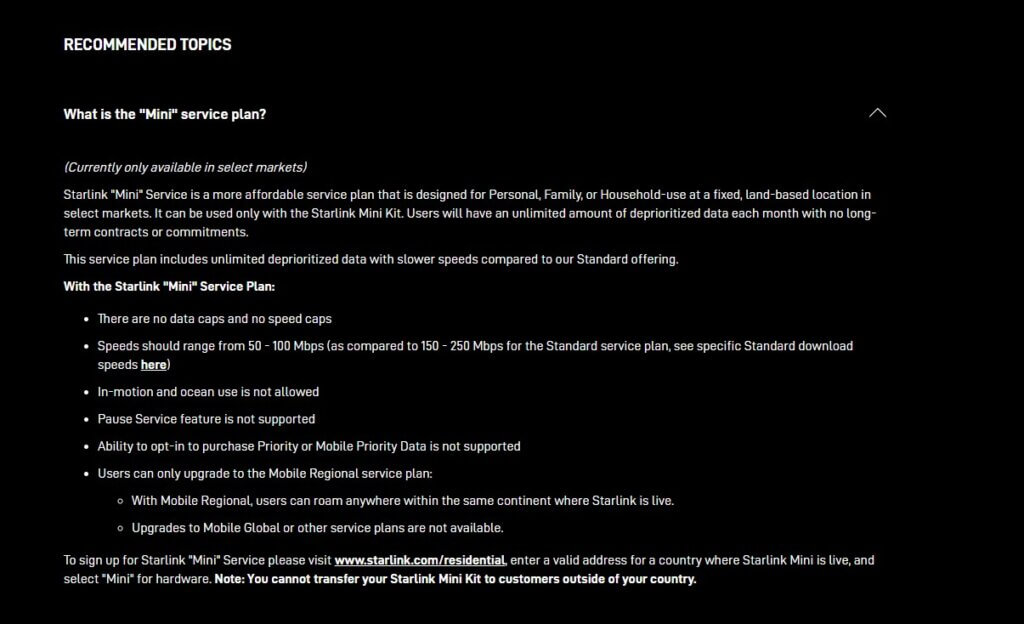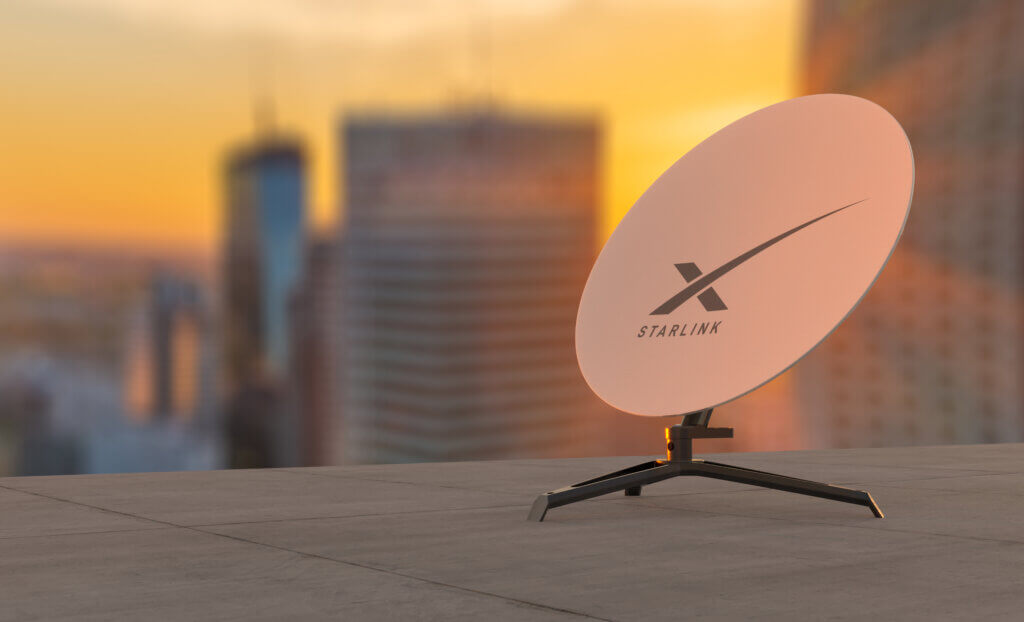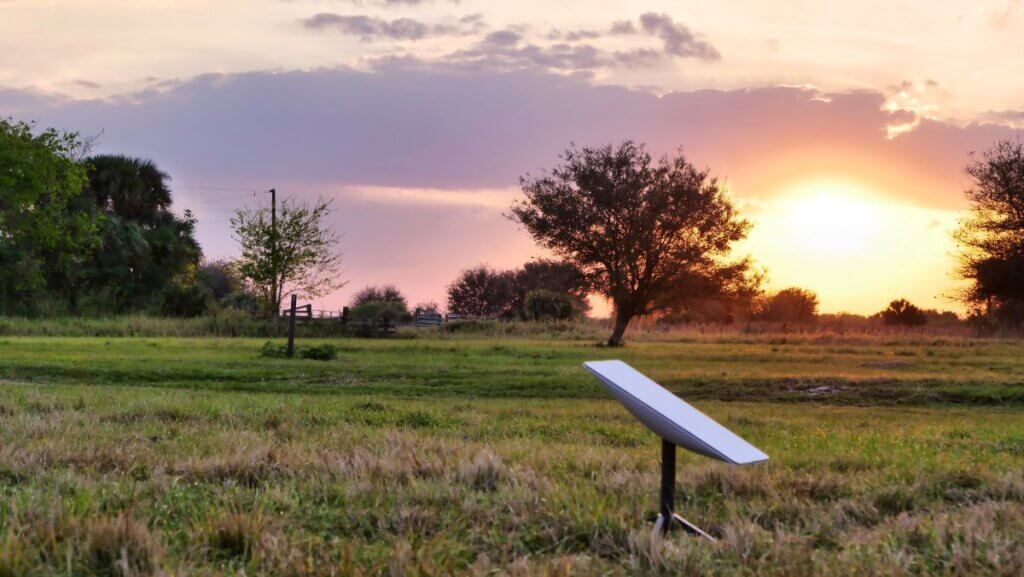Table of Contents

About the author
Rosslyn Elliott
Watch our provider review videos
Video ReviewsWhich speed do I need?
Tell us what you use Internet for
How many users?
On June 19, SpaceX began a restricted rollout of its new Starlink Mini satellite internet dish in the United States. The launch, which ended on July 4, has met with critical reactions from potential customers.
The compact, portable device known as the Mini promises high-speed internet access on the go. But the launch’s high U.S. prices and data caps have caused backlash from tech journalists, boat and RV owners, and existing Starlink users.
Starlink Mini: A Compact Solution for Portable Internet
The Starlink Mini represents a significant step forward in portable satellite internet technology. Designed to fit easily into a backpack, the Mini offers several advantages over the larger standard dish:
- Built-in Wi-Fi router
- Lower power consumption
- DC power input
SpaceX CEO Elon Musk highlighted the device’s potential, stating on social media platform X: “I just set it up right now and am writing this post through space. Took less than 5 mins. Easily carried in a backpack. This product will change the world."
Technical Specifications
The Starlink Mini measures 11.75 x 10.2 x 1.45 inches and weighs just 2.43 pounds. Its compact size and DC power compatibility would potentially make it an attractive option for RV owners, boaters, and other mobile users seeking reliable internet access in remote locations.
Power Consumption and Battery Life
The Mini’s power efficiency is a significant improvement over previous models. It consumes an average of 25-40W, allowing for extended use with portable power banks. Users can expect two to three hours of operation from a 27,650mAh power bank, or about an hour from a smaller 10,000mAh battery.

(photo credit Michael Nicholls)
U.S. Launch Strategy Raises Questions
Despite the Mini’s apparent advantages, Starlink’s launch strategy in the United States has irritated many potential customers.
The company offered the Mini on an invitation-only basis to existing Starlink residential customers for two weeks. The introductory offer included:
- Starlink Mini hardware priced at $599
- “Mini Roam" service plan for an additional $30 per month added to an existing $120 Residential Plan for a total of $150/month
- 50 Gigabyte (GB) monthly data cap, with additional data charged at $1 per GB
This pricing structure contrasts sharply with Starlink’s approach in other markets.
In four countries including Colombia, El Salvador, Guatemala, and Panama, the company now offers the Mini for only a $200 equipment purchase price. Customers in these countries pay only $35 monthly for unlimited data and can purchase the Mini Roam plan on its own.
That low-priced offer continues to be available to customers in those four nations, unlike the terminated U.S. offer.

Usage Restrictions and Limitations
The initial U.S. offer of the Starlink Mini Roam plan came with several restrictions. If these limits continue in a future U.S. launch, they will reduce the Mini’s appeal to certain user groups:
- In-motion and on-water usage is not allowed, though near-shore and low-speed (under 10 mph) use is permitted
- The service subscription cannot be paused when not in use
- Users must maintain an active Starlink Residential plan to use the Mini Roam service
Impact on RV and Boat Users
These restrictions would harm the Mini’s usefulness for nomadic users.
The data cap and inability to pause service would make the Mini less appealing for occasional travelers.
Full-time nomads would face additional challenges. In the limited rollout, there was no standalone Mini option without a Residential plan. Clearly, RV users on the move do not need a residential plan and would be unlikely to pay for one.
The Mini Dish temporary release may have been strategically priced to be no lower than the price of the Starlink Mobile Regional Plan, which is also $150/month. That plan, which would usually be the choice of an RVer, uses traditional Starlink hardware with a larger dish.
International Roaming Considerations
Initially, Starlink stated that for U.S. customers, Mini Roam coverage would be limited to the USA.
This restriction has since been removed from the FAQ, potentially opening the door for continental roaming into Mexico and Canada.
But it is also possible that the U.S. release is simply not included in the current Starlink FAQ, given that for now, the Mini is no longer available for order in the United States.

User Reactions and Criticisms
The rollout’s U.S. pricing and data caps sparked criticism from potential customers.
Reddit users expressed disappointment, as one said: “Rip off, cash grab. Should be 0.10 cents per additional GB with upfront cost of $250 at most. Starlink fumbled this. Guarantee this thing flops."
Another Reddit user highlighted concerns about the data cap’s practicality: “I would have had no issue paying the $600 if not for the 50GB cap. I don’t need a TByte, but a weekend camping and someone’s computer that downloads a game update will wipe 50GB in just over 1 hour at 100Mbit speed."
Matthew Williams, a U.S.-based Starlink customer who already purchased the Mini dish, told PC Magazine that the terminal’s performance has been good, but the data cap is not feasible. “It would be way too limiting for most people,” Williams said. “To give you an idea, we use about 300 GB per month for our main Starlink dish.”
Potential for Future Changes
The company has hinted at possible changes to the Mini’s pricing and availability. The current “Mini Roam" service plan was only made available on June 19, then the order period ended on July 4. The short two-week order period may indicate that Starlink is planning to revise its future Mini offerings based on initial user feedback and network performance data.
Journalists Respond to Starlink’s Strategy
Technology journalists have proposed reasons that could explain Starlink’s unexpected approach to the Mini launch.
Targeting Developing Markets
The Mini may be primarily intended to increase Starlink’s market share in countries with less developed internet infrastructure.
Starlink implied this was a goal in identical phrasing used in its email to customers and on its support page, stating: “Our goal is to reduce the price of Starlink, especially for those around the world where connectivity has been unaffordable or completely unavailable."
This strategy could explain the more attractive pricing and lack of data limits in certain international markets. In many countries, residents simply cannot afford the higher prices that Starlink can demand in the U.S.
Of course, many U.S. residents also cannot afford those higher prices, but Starlink may be more concerned with its own global reach than with increasing digital opportunity for Americans.
Network Congestion Concerns
Chris Dunphy of RVMobileInternet.com suggested that the Mini’s smaller antenna may be less efficient than the standard Starlink dish, potentially placing a higher load on the satellite network. This could explain the data caps and higher pricing in congested markets like the U.S.
Starlink may be taking a cautious approach to the Mini’s U.S. rollout due to concerns about network capacity and performance.
Implications for the Satellite Internet Market
The Starlink Mini’s launch represents a significant development in the satellite internet industry.
The antenna’s compact size and portability could open up new markets for satellite internet technology. But the success of the Mini will depend on Starlink’s ability to balance pricing, data allowances, and network capacity to meet user expectations.
Comparison with Other Starlink Plans
The initial U.S. Mini Roam plan differed significantly from existing Starlink offerings:
- The temporary rollout had data caps, while the $150/month Mobile Regional plan has unlimited data
- The Mini’s limited rollout had no option to upgrade to an unlimited data plan
Technical Performance
The Mini offers lower speeds than the standard Starlink service (50-100 Mbps vs. 150-250 Mbps). But the antenna still provides enough bandwidth for most users’ needs, including video streaming and general internet use.

When Will the Starlink Mini Dish Be Available in the U.S.?
Since the initial two-week rollout ended on July 4, the Starlink Mini is not currently available to order in the U.S. Only Central American customers can order a Mini.
As Starlink continues to expand its satellite constellation and improve network capacity, we may see changes in the Mini’s pricing and availability.
But the big question now may be, will Starlink release the Mini Dish widely in the U.S. at all?
Starlink has over 3 million customers globally already. The company would be unlikely to release a much cheaper product that would cannibalize its own business in countries with wealthier customers, such as the USA.
Starlink may decide to release the Mini Dish only in countries where almost all the residents cannot afford standard satellite internet and full-sized dishes.
We will be keeping an eye on any developing offers for the Starlink Mini to see whether a U.S. offer will return, and if so, when.
FAQs: Starlink Mini Dish
What is the Starlink Mini?
The Starlink Mini is a compact, portable satellite internet terminal designed by SpaceX. It’s smaller and more power-efficient than previous Starlink models, measuring 11.75 x 10.2 x 1.45 inches and weighing just 2.43 pounds. It features a built-in Wi-Fi router and DC power input, making it suitable for use in remote locations or while traveling.
Is Starlink Mini currently available in the USA?
No, the Starlink Mini is not currently available in the USA. SpaceX briefly tested a limited rollout for two weeks, ending on July 4, 2024. Since then, the Mini has not been available for order in the United States. It’s uncertain when or if it will be widely released in the US market.
Who would benefit from the Starlink Mini?
People who move around frequently, such as RV owners or backpackers, would enjoy the portability of the Starlink Mini. In rural areas, residents would benefit from Starlink Mini if its price were lower than standard satellite internet, as it currently is in four Central American countries. It appears unlikely that Starlink will offer that low-priced service to rural customers in the USA.
How does the pricing of Starlink Mini differ between the US and other countries?
During the limited US rollout, the Starlink Mini was priced at $599 for the hardware, with a $30 monthly “Mini Roam" service plan on top of the existing $120 Residential Plan. In contrast, in Colombia, El Salvador, Guatemala, and Panama, the Mini is offered for a $200 equipment purchase price with a $35 monthly unlimited data plan.
What were the main criticisms of the Starlink Mini’s limited US launch?
The main criticisms from users and journalists included high prices, data caps (50 GB monthly with $1 per GB after), inability to pause service, requirement of an active Residential plan, and restrictions on in-motion and on-water usage. Many potential customers found these terms limiting and expensive compared to other Starlink offerings and international pricing.
Why might Starlink be taking a different approach with the Mini in the US versus other countries?
There are several potential reasons that Starlink may have chosen the limited two-week launch in the United States.
- Starlink may be primarily targeting developing markets with less robust internet infrastructure.
- Network congestion concerns in the US might be leading to a more cautious rollout.
- The company may be trying to avoid cannibalizing its existing, higher-priced services in wealthier markets like the US.
- Starlink might be using the limited US rollout to gather data and user feedback before deciding on a wider release strategy.

Source: Text of Starlink Mini Email Sent to Select U.S. Starlink Customers
Email sent with invitation-only offer on June 19, 2024
Introducing Starlink Mini
You are invited for early access. Order by July 4th, 2024.
Starlink Mini Studio
Starlink Mini is a compact, portable kit that can easily fit in a backpack, designed to provide high-speed, low-latency internet on the go.
Starlink Mini includes a built-in WiFi router, lower power consumption, DC power input, and max download speeds over 100 Mbps*. See Starlink Mini specifications here.
You are invited to purchase the Starlink Mini Kit for $599 and bundle the Mini Roam service with your existing Residential service plan for an additional $30/mo.
Our goal is to reduce the price of Starlink, especially for those around the world where connectivity has been unaffordable or completely unavailable. But in regions with high usage, where Starlink Mini places additional demand on the satellite network, we are offering a limited number of the Starlink Mini Kits to start for $599.
Our first 10,000 orders will be shipped ahead of July 4th. Remaining orders will take 2 to 4 weeks to ship.
ORDER NOW
Starlink Mini Roam Service Plan
Starlink Mini Lifestyle
We are offering Starlink customers the option to bundle Starlink Mini with their Residential service.
The Mini Roam service is an additional $30/mo for 50GB of Mobile data that can be used anywhere in the United States ($1/GB for additional data).
You must continue your Residential service on your current Starlink to use Mini Roam service.
This invitation is only valid for one order on this account (xxxxx)
Customers cannot trade-in their current Starlink for Starlink Mini.
How to Order
1. Click Order Now below
2. Select “Mini" option for your hardware
3. Check out and pay
ORDER NOW
Space Exploration Technologies Corp | 1 Rocket Road, Hawthorne, CA 90250
Related Posts

About the author
